Easter Egg Number Matching Game
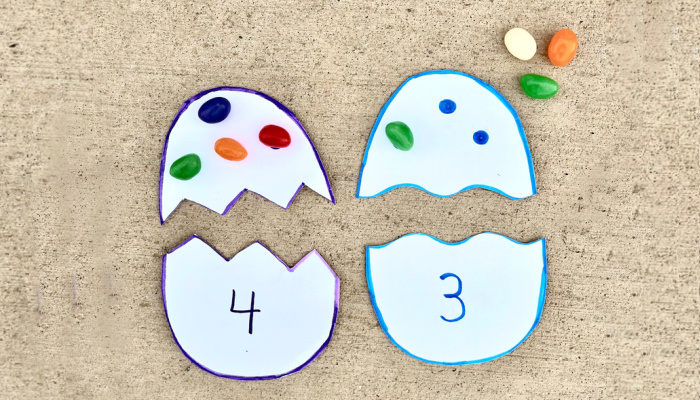
This post may contain affiliate links; please see our terms of use for details.
There’s something so fun about bunnies, eggs, chocolate, and springtime. Spring is one of my favorite seasons, and Easter is one of my favorite holidays. This time of year, our family goes crazy for adorable Easter-themed crafts and activities.
After a long winter full of snow, cold weather, and darker colors, we love the change to sunny days with bright-colored flowers. I love to create crafts and activities that brighten up our homeschool days. This Easter Egg Number Matching Game is sure to do that!
My three-year-old is very interested in identifying numbers. She points them out on houses and tries to draw them on paper. If your child is starting to show interest, it’s the perfect time to introduce preschool math activities like this one.
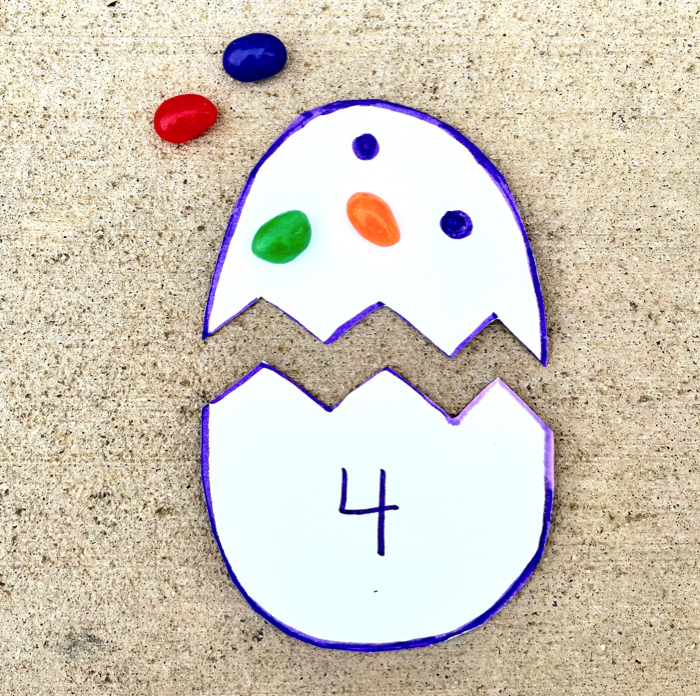
With only a few minutes of spare time, I created this game using paper, markers, and Easter candy I picked up from the Dollar Tree. You don’t need to spend a fortune on math games when you can create your own for just a few dollars.
To make this Easter Egg Number Matching Game, grab some Easter candy and follow along!
Easter Egg Number Matching Game: What You’ll Need
I chose to go simple with the design of this matching game. Here’s all I used to create this preschool math activity:
Materials:
- White cardstock paper
- Markers
- Scissors
- Jelly beans or other Easter candy
Setup:
If you can draw an oval, that’s all the expertise you’ll need to create this game. You can jazz up the eggs with glitter or multiple colors or leave them simple like I did.
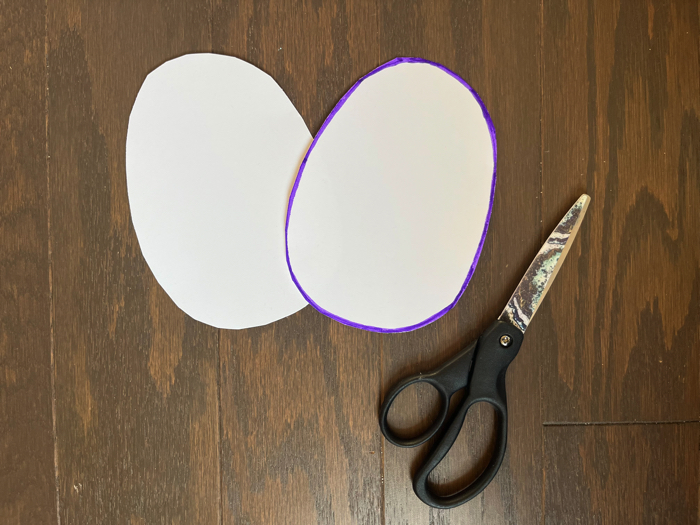
Step 1: Using a marker, draw an oval shape on a piece of white cardstock paper. Cut out the oval.
Helpful hint: To cut several pieces at once, stack a few pieces of paper under the oval before cutting. This will also give you a uniform shape on the eggs.

Step 2: Create a cut line on the eggs. Try varying the line by using curves and angles. Since these eggs work like a puzzle, you don’t want all the egg pieces to be the same.
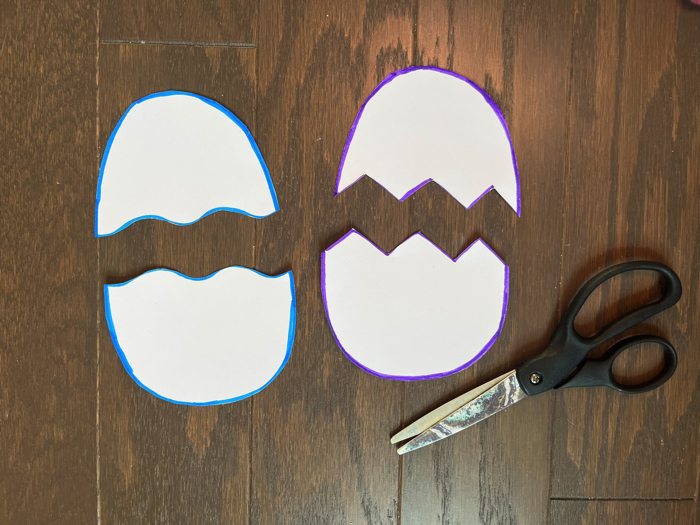
Step 3: Write a number from 1 to 10 on the bottom of the egg. On the top of the egg, create dots to match the number.

Step 4: Cut the top and bottom of the eggs apart.
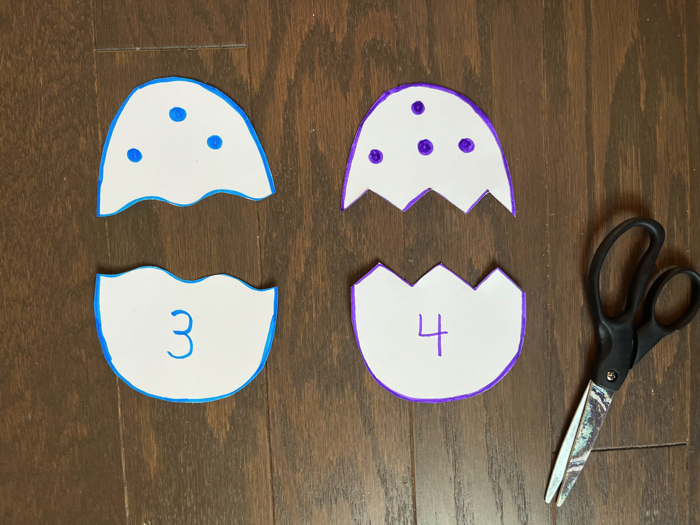
Time to Play
Once the eggs have been cut, it’s time to play. Here are a few ways we used this set for learning and fun:
Number Recognition
Recognizing numbers and identifying their names are important kindergarten skills. This number game can help your child identify numbers 1-10.
Lay the egg pieces on a table. Show your child how to read the number and then find the matching egg half with the corresponding number of dots. As your child counts, you may need to help them count slowly and point to one dot at a time.
One to One Correspondence
One-to-one correspondence sounds complicated, but it’s actually very simple. One-to-one correspondence refers to the ability to count items one at a time. When your child points to just one jelly bean and says, “One,” they are using this skill.
To practice this skill, give your child a bowl of jelly beans. Have your child select a paper egg and cover the dots with jelly beans. Help your child count slowly, only placing one jelly bean on each dot.
Addition
It’s never too early to start working on basic addition skills. This egg and jelly bean game can easily be used to practice adding.
Using one egg, place jelly beans on only some of the dots. Leave some dots empty so your child can fill in the rest. Have your child look at the dots and tell you how many jelly beans are missing.
After your child answers, show them the addition problem they just solved. For example, you might say, “That’s right. There are five total dots and I covered two dots with jelly beans. If we add three more jelly beans, we’ll cover all five. That means two plus three makes five.”
Subtraction
Learning to subtract can be tricky. I’ve found that my children learn this skill best when given visuals. You can practice basic subtraction skills using the jelly beans.
Take one egg and cover all the dots with jelly beans. Count all of the beans together. Ask your child to remove just one jelly bean.
With one jelly bean missing, ask your child to count the beans again. Using their answer, tell them the subtraction problem they helped solve. You might say, “Great work. We had five jelly beans but you took one away. That left us with four jelly beans. That means five minus one equals four.”
Continue taking just one more away until they are all gone.
What can I use instead of jelly beans?
- PACKAGE INCLUDE: 60 x Colored Counting Bears. There are 6 colors in each set, which are green, red, yellow, purple, blue and orange.
- BRIGHT COLOR: Each bear has a bright color. It can better let your child exercise hands-on ability, classify ability, and cultivate an interest in learning.
- TEACHING TOOLv: vThe weight of each bear is 3g. You can exercise your child’s counting ability and provide a relaxing learning atmosphere for your child through toys.
- IMPROVE ABILITY: Each bear has a bright color that stimulates learning. It can better let your child exercise hands-on ability, classify ability, and cultivate an interest in learning.
We like jelly beans for this activity because they are the right size for tiny fingers to hold. However, there are plenty of other options! Pom poms, mini marshmallows, counting bears, or Skittles will work as well.
Another option is to use dot markers. With dot markers, your child can stamp over the dots on the eggs. These markers are a great tool to have on hand for fun, accessible math number activities.
What other ways can I teach number recognition and counting skills?
Counting and number recognition are both necessary skills for success in math. You can provide your child with extra practice almost anywhere. Here are our favorite number activities for preschoolers on counting and number recognition.
Singing Number Songs
Does your little one love to sing? Try a number song to reinforce counting skills while having fun.
We’ll often play fun kids’ songs in the car while we travel. Many of these songs include finger-play tunes. Some of our favorites include Five Little Speckled Frogs, Ten Little Monkeys, and Five Little Ducks.
As your child sings, show them the correct number of fingers to hold up in the air. Learning to hold up one finger for each number is another way to practice one-to-one correspondence.
Counting Bath Toys
Why not turn bathtime into learning time? My kids always have a plethora of toys in the tub. This allows us to practice counting.
Have your child line up their toys on the side of the tub. Show them how to count the toys one by one. As they say the number, they can make the toy dive into the tub just for fun.
Number I Spy
While driving in the car, my kids like to play I Spy games where I give them an object to look for. We’ve done this with animals, letters, and numbers.
To play I Spy using numbers, call out a number for your child to hunt for. This is best played when there are plenty of signs and license plates to look at. You can also call out a number and have your child find that number of items, such as five mailboxes.
Hopscotch
This classic sidewalk game is a fantastic tool for number recognition. Draw a hopscotch board on the sidewalk and number each square. Show your child how to hop on each number and name the number they’re standing on.
You can also have your child take a beanbag and throw it on a number you call out.
Elevator Buttons
“Elevator Buttons” has been a favorite counting activity in our home for years. To create this game, create a “panel of elevator buttons” using a piece of paper and number stickers. Place the number stickers on the paper in rows just like you’d find in an elevator.
Hang the paper inside a closet or room next to the door. Enter the room with your child, shut the door, and have them press the floor number that you call out. Have fun exiting and entering the elevator and riding to different floors.
Number Egg Hunt
To play this game, fill Easter eggs with pieces of paper that have a number written on them. Hide the eggs around the house and have your child hunt for them. After finding the eggs, have your child open each egg and put the numbers in order.
This is a similar game to our Sight Word Easter Egg Hunt. You can also fill the eggs with alphabet letters, shapes, or anything else you want your child to learn.
What other ways can I enrich this activity?
- Can you tell how many cherries there are? How many apples?
- Children will love solving the puzzles of this clever, vibrant book.
- Bilingual edition will also allow them to match English & Spanish.
- Contains 20 pages and measures 5.00 x 6.85in.
To extend the learning, try one of these counting activities:
- Create this Apple Seed Counting Game
- Read My Very First Book of Numbers by Eric Carle
- Try one of these glowing Easter egg activities
- Make these Silly Spinning Easter Eggs

Related Posts

Holiday Crafts and Ideas
Should Parents Lie to Their Kids About Santa Claus?
Should parents lie about Santa? Find out how to balance trust, magic, and holiday traditions right here!
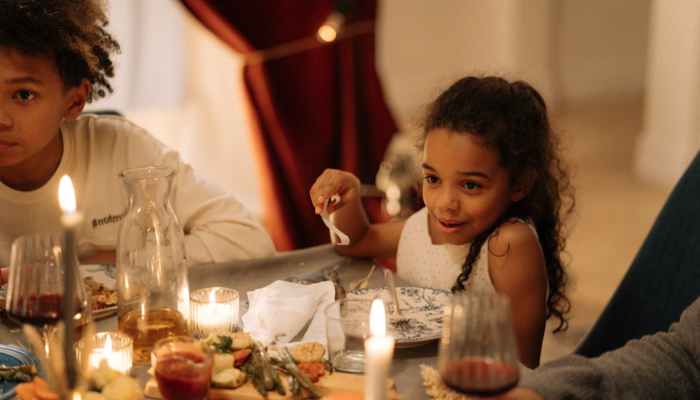
Holiday Crafts and Ideas, Special Needs
5 Tips for a Peaceful Thanksgiving with Your Child with Disabilities
Thanksgiving can be a joyful yet overwhelming holiday, especially for families with children who have sensory, motor, or dietary needs.

Math and Science
4 Weather Activities for Preschoolers
Whether the weather is sunny, cloudy, windy or rainy check out these educational weather activities for preschool that your children will love!

